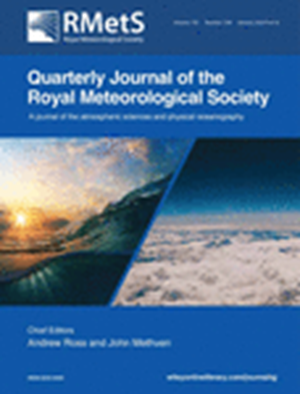通过混合改善对流尺度集合中降水的传播-技能关系
IF 3
3区 地球科学
Q2 METEOROLOGY & ATMOSPHERIC SCIENCES
引用次数: 0
摘要
对流尺度集合在世界各地的业务中心被常规用于制作降水概率预报,但由于成员之间缺乏扩散,导致预报经常过于自信。这一不足可以通过扩大范围、提高预报精度或两者兼而有之来弥补。英国气象局预报系统的最新发展是在对流尺度数据同化方案中加入大尺度混合(LSB)。这种方法旨在通过减少对流尺度数据同化在尺度上的影响来减少分析中的天气尺度预报误差。这些尺度将使用全球数据同化方案的输出进行初始化,我们希望这样做能减少预报误差,从而改善传播-技能关系。在这项研究中,我们通过在为期 17 天的夏季试验期间比较有无 LSB 的预报集合,量化了 LSB 对每小时降水累积的传播-技能关系的影响。试验发现,使用基于分数技能得分的指标计算,传播-技能关系得到了适度但显著的改善。在最大尺度上,较低降水百分位数的技能平均提高了 0.56%,但相应的传播能力下降限制了整体修正效果。在较高的百分位数中,传播-技能差异的减少幅度最大,这是因为传播反应更为平缓,在较大尺度下,传播-技能差异的显著减少幅度可达 0.40%。使用本地化分数技能评分的新扩展进行的案例研究分析表明,分散技能的改进如何转移到较小尺度的特征上,而不仅仅是混合的尺度上。有迹象表明,通过在集合中更充分地实施局部分数技能,可以进一步提高传播技能,我们鼓励气象局继续开发这一技术。本文章由计算机程序翻译,如有差异,请以英文原文为准。
Improvements in the spread–skill relationship of precipitation in a convective‐scale ensemble through blending
Convective‐scale ensembles are used routinely in operational centres around the world to produce probabilistic precipitation forecasts, but a lack of spread between members is providing forecasts that are frequently overconfident. This deficiency can be corrected by increasing spread, increasing forecast accuracy, or both. A recent development in the Met Office forecasting system is the inclusion of large‐scale blending (LSB) in the convective‐scale data assimilation scheme. This method aims to reduce the synoptic‐scale forecast error in the analysis by reducing the influence of the convective‐scale data assimilation at scales that are too large to be constrained by the limited domain. These scales are instead initialised using output from the global data assimilation scheme, which we expect to reduce the forecast error and thus improve the spread–skill relationship. In this study, we quantify the impact of LSB on the spread–skill relationship of hourly precipitation accumulations by comparing forecast ensembles with and without LSB over a 17‐day summer trial period. This trial found modest but significant improvements to the spread–skill relationship as calculated using metrics based on the Fractions Skill Score. Skill is improved for a lower precipitation centile by an average of 0.56% at the largest scales, but a corresponding degradation of spread limits the overall correction. The spread–skill disparity is reduced the most in the higher centiles due to a more muted spread response, with significant reductions of up to 0.40% obtained at larger scales. Case‐study analysis using a novel extension of the Localised Fractions Skill Score demonstrates how spread–skill improvements transfer to smaller‐scale features, not just the scales that have been blended. There are promising signs that further spread–skill improvements can be made by implementing LSB more fully within the ensemble, and we encourage the Met Office to continue developing this technique.
求助全文
通过发布文献求助,成功后即可免费获取论文全文。
去求助
来源期刊
CiteScore
16.80
自引率
4.50%
发文量
163
审稿时长
3-8 weeks
期刊介绍:
The Quarterly Journal of the Royal Meteorological Society is a journal published by the Royal Meteorological Society. It aims to communicate and document new research in the atmospheric sciences and related fields. The journal is considered one of the leading publications in meteorology worldwide. It accepts articles, comprehensive review articles, and comments on published papers. It is published eight times a year, with additional special issues.
The Quarterly Journal has a wide readership of scientists in the atmospheric and related fields. It is indexed and abstracted in various databases, including Advanced Polymers Abstracts, Agricultural Engineering Abstracts, CAB Abstracts, CABDirect, COMPENDEX, CSA Civil Engineering Abstracts, Earthquake Engineering Abstracts, Engineered Materials Abstracts, Science Citation Index, SCOPUS, Web of Science, and more.

 求助内容:
求助内容: 应助结果提醒方式:
应助结果提醒方式:


